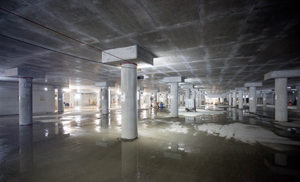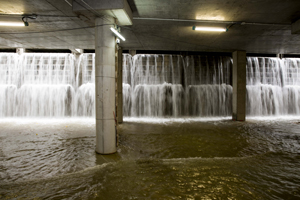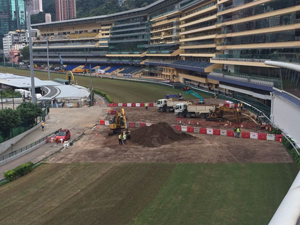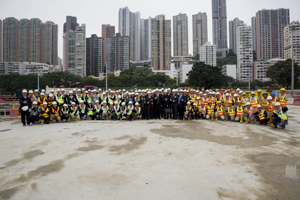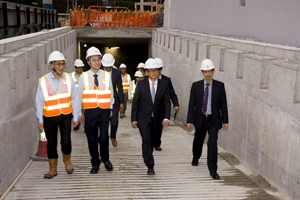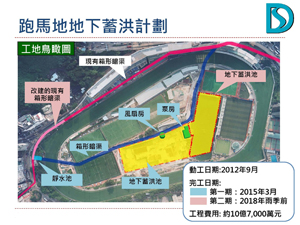Happy Valley Underground Stormwater Storage Scheme
|
Earlier on, the Hong Kong Observatory (HKO) forecast that the rainfall in Hong Kong will be normal to relatively low this year, but it reminded us to remain vigilant at all times for extreme weather. I remember that in the first half of last year, there were two black rainstorm warnings and a number of periods of sudden torrential rainfalls in the territory, which posed a great challenge to our flood prevention infrastructure. The Drainage Services Department (DSD) has been taking precautionary measures and striving to provide quality flood prevention facilities for the community. One example is Phase 1 of the Happy Valley Underground Stormwater Storage Scheme (HVUSSS), which commenced operation in late March. Wan Chai has seen severe flooding in the past, and people’s living and business operation have been seriously affected. As Wan Chai and Happy Valley are located in low-lying areas and are densely populated, it is not easy to carry out large-scale flood prevention works which involve road excavation without disrupting people’s daily lives. As such, the DSD decided to adopt underground stormwater storage scheme as one of the strategies for flood prevention to minimise the impacts of works on the local community. After careful investigation, planning and design, the DSD chose the Happy Valley Recreation Ground which is the lowest point in the area to launch the underground stormwater storage scheme. As the works at the Happy Valley Recreation Ground would affect the race track of the Hong Kong Jockey Club (HKJC), jogging paths, and soccer and rugby activities inside the racecourse, the DSD had to consider the impacts on all these aspects in works design and planning. The entire project, therefore, is being carried out in two phases, each of which involvin the construction of a stormwater storage tank with a capacity of up to 30 000 cubic metres. The HKJC also took proactive steps to facilitate construction of the cross-track flood relief box culvert and turf reinstatement within four months by rescheduling the 2014 off-season from July to September to June to October. To ensure that the horse-racing season IN 2015will begin as scheduled, the DSD has made every endeavor in implementing the works in non-race days and off-season. Special arrangements are made for race days on Wednesdays, including no construction works after 5pm, putting away sign boards and stopping all noise-making machinery, as well as lowering the high-rise parts of machinery and moving them away from the race tracks, so as to avoid blocking the sightline from grandstand and ensure that there will be adequate space for the HKJC’s horse races. In addition, the DSD will close no more than three soccer or rugby pitches during each phase of works. A ball-picking hotline has been set up during the course of construction to provide service for pitch players who have accidentally kicked their balls into the works sites, so as to prevent them from going into the work sites and to ensure their safety. The HVUSSS has many innovative elements. Its Water Harvesting System collects and treats groundwater, irrigation water and rainwater from sports pitches for reuse in watering sports pitches and toilet flushing after treatment. It is estimated that 220,000 cubic metres of precious water can be saved every year. Of particular interest is the intelligent design of movable weirs. They are operated automatically and controlled by water level sensors located at the storage tank and the culvert downstream and HKO tide gauge at Quarry Bay by using real-time data of water and tidal levels. When rainfall intensity is low, the weirs will be kept closed and stormwater will flow along the box culvert. When rainfall intensity increases, the weirs will partly open automatically to enable stormwater overflow into the tank for temporary storage, and the weirs will open after the flood is over to allow most of the stored stormwater flow back into the box culvert by gravity while the remaining stormwater will be drained by stormwater pumps. The HVUSSS has gained recognition from international professional organisations for its innovative elements by winning the 2012 International Water Association Project Innovation Awards (East Asia Regional Awards) in the Planning Category. The HVUSSS is a large and complex project. Its Phase 1 construction works were completed in just about two years’ time due to the co-operation and close collaboration among the DSD, the main contractors and its sub-contractors through various effective communication platforms, thus avoiding unnecessary disputes during the construction and ensuring excellent performance in the delivery and quality of the project, occupational safety and health and environmental protection. The project has demonstrated the partnering spirit of the New Engineering Contract. The whole project is expected to be completed before the rainy season in 2018. By then, flood protection in Wan Chai and Happy Valley will be enhanced. |
|
5 April, 2015
Back